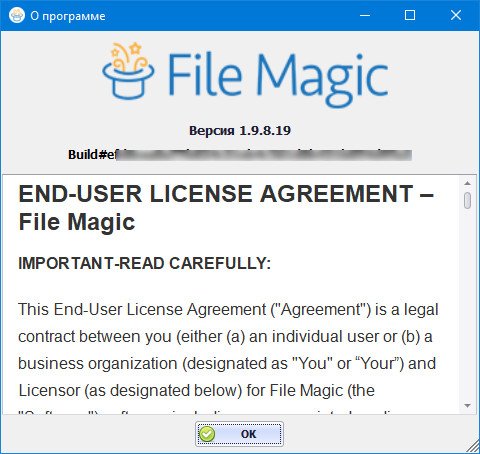While working on an urgent project, a co-worker sends you a critical C19 file you urgently need—but when you double-click it, you’re greeted by that ominous Windows alert:
 “Windows can’t open this file (C19). Try an app on this PC.”
“Windows can’t open this file (C19). Try an app on this PC.”
You scramble to find a solution online, only to be overwhelmed by conflicting advice and sketchy downloads. Before long, trial software floods your machine, Task Manager reports soaring CPU usage, and your looming deadline—tomorrow—feels impossibly out of reach.
Enter FileMagic: the single application that empowers you to open, preview, extract, decrypt, and convert hundreds of file formats—including obscure or proprietary types like C19—without installing a dozen specialized tools. Designed for professionals, developers, educators, and everyday users alike, FileMagic replaces your entire suite of format-specific viewers with one lightweight, lightning-fast program. If you have any queries regarding wherever and also how you can work with C19 file viewer software, it is possible to email us from our web-site. No license transfers, no extra downloads: simply install FileMagic, drag in your files, and gain instant access.
At the heart of FileMagic lies our patented binary-analysis engine. Rather than relying on file extensions alone, FileMagic inspects each file’s signature at the lowest level, automatically identifying its format and selecting the optimal internal routine to open it. That means you can break free from the endless hunt for the “right” application every time you encounter a C19 file, an obscure scientific dataset, or even an encrypted archive. Our intelligent engine decodes headers, verifies checksums, and applies built-in decryption routines—so you never see a “Windows can’t open this file” pop-up again.
Ease of use is paramount. FileMagic’s clean, ad-free interface lets you drag and drop any file—images, documents, audio/video, archives, CAD drawings, email archives, legacy formats, or your C19 attachments—and instantly preview or extract its contents. One click converts between formats, and batch processing lets you configure output settings once and then convert hundreds of files in seconds. Whether you need to extract text from a batch of reports or convert a series of video clips for your presentation, FileMagic handles it all without breaking a sweat.
For software developers, FileMagic is an indispensable component of your toolkit. Integrate its command-line interface and API hooks directly into build scripts, CI/CD pipelines, or custom tooling to automate decryption, parsing, and normalization of C19 files (or any other format). Ingest proprietary data logs, reverse-engineer legacy binary blobs, or validate encrypted payloads for secure transmission—FileMagic recognizes headers, applies the correct routines, and exposes the underlying content in a consistent, standardized format. By automating format translation, you eliminate manual conversion steps and reduce compatibility issues across development, staging, and production environments.
Cost savings are immediate. Expensive, format-specific licenses quickly add up—especially when you need to open a single C19 file for one project. With FileMagic, there’s no need to pay for add-on modules or per-format subscriptions. Our all-inclusive model covers hundreds of common and niche formats out of the box, saving you both time and money. Instead of tying up your budget on a $200 viewer you’ll never use again, FileMagic gives you universal access for a fraction of the cost.
Security and privacy are built in from the ground up. Files downloaded from the internet can harbor malware or spyware, but FileMagic isolates every document in a secure sandbox before rendering. Our integrated virus and threat detector scans for suspicious patterns as soon as a C19 or other file is loaded, alerting you to any potential risks before they can reach your system. Because all processing happens locally—no cloud uploads, no external dependencies—you maintain complete control over your data and comply easily with privacy regulations.
Cross-platform compatibility ensures that FileMagic fits seamlessly into any environment. Whether you work on Windows, macOS, or Linux, our native integrations mean you can preview files directly in File Explorer, Finder, or your terminal of choice. Context-menu extensions let you open C19 files with a right-click, and command-line tools support scripting on headless servers or within Docker containers. No matter your workflow, FileMagic adapts to your platform.
Unlike bulky suites that run hidden background services and slow your machine, FileMagic remains lightweight and resource-efficient. Our optimized code footprint ensures fast startup times and minimal memory usage, so you won’t notice FileMagic sitting in the background—only when you need it. Say goodbye to sluggish performance caused by multiple viewers installed side-by-side and hello to a single, streamlined application that does it all.
Imagine never having to wonder whether you’ve downloaded the correct program to open a C19 file again. Picture an environment where every employee, contractor, or collaborator can preview attachments—regardless of format—in seconds, without IT intervention or software hoarding. That’s the power of FileMagic. From financial institutions handling encrypted client data to graphic designers reviewing proprietary design files, FileMagic brings universal compatibility and rock-solid security to every user.
Stop wrestling with “Windows can’t open this file” errors, end the frustration of format hunts, and reclaim your productivity. Download FileMagic today and unlock seamless digital workflows—wherever you are, whatever you do, and whatever file formats you encounter. With FileMagic, you hold the key to every format.
 While working on an urgent project, a co-worker sends you a critical C19 file you urgently need—but when you double-click it, you’re greeted by that ominous Windows alert:
While working on an urgent project, a co-worker sends you a critical C19 file you urgently need—but when you double-click it, you’re greeted by that ominous Windows alert: